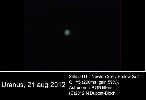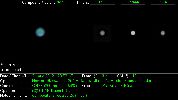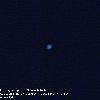A l'oculaire du Celestron 5, Uranus est une étoile évidente
de magnitude 5,7 (limite de visibilité à l'oeil nu par ciel sombre), sa
couleur n'est pas flagrante. Elle montre un minuscule disque, comme une nébuleuse planétaire très petite
mais contrastée. La webcam a vraiment eu du mal, même
avec ce faible grossissement. C5 f/D=20 avec Barlow 2x Ultima, ToUCam Pro II en mode couleurs optimisées:
l'image est trop bleutée.
|
Through the eyepiece of the Celestron 5, Uranus
is easily visible like a star with a magnitude of 5.7 (barely visible
with naked eye under a dark sky), its color is not conspicious. It shows a tiny disk, like a very little but
highly contrasted planetary nebula. The webcam hardly
captured it, even at this weak magnification. C5 at f/D=20 with Barlow Ultima 2x, ToUCam Pro II in
optimized colors mode, the image is too blueish.
|







 up
up